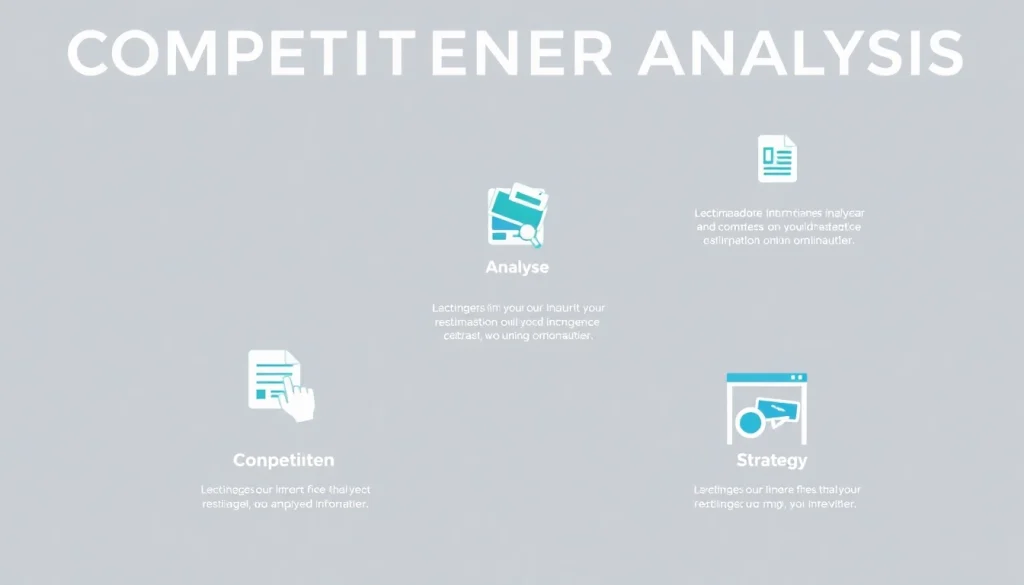
Understanding Competitor Analysis
What Is Competitor Analysis?
Competitor analysis, also known as competitive analysis or competition analysis, is an essential strategic approach used by businesses to understand their competitive landscape. It involves examining similar brands within your industry to gain insights into their offerings, branding, sales strategies, and marketing approaches. By analyzing competitors, businesses can identify their market position and understand the dynamics of competition, which can help in decision-making and strategic planning.
Why Is Competitor Analysis Important?
Understanding your competitors is crucial for several reasons. First, it allows you to identify market trends and shifts in consumer preferences, giving you the opportunity to adapt accordingly. Second, competitor analysis helps you pinpoint the strengths and weaknesses of your own offerings compared to others in the market. This intelligence facilitates the development of strategies that can enhance your competitive edge.
Moreover, engaging in competitor analysis can inform your marketing strategy, product development, and customer acquisition efforts. Knowing what your competitors are doing well—or poorly—enables you to differentiate your business in a crowded marketplace. In fact, an effective competitor analysis can lead to improved ROI by refining your marketing and operational strategies.
Key Components of Competitor Analysis
To conduct a thorough competitor analysis, businesses should consider several critical components:
- Competitor Identification: Recognize key players in your industry, including direct and indirect competitors.
- SWOT Analysis: Evaluate competitors’ strengths, weaknesses, opportunities, and threats, allowing you to understand their market positioning.
- Market Share Analysis: Analyze competitors’ market shares to identify industry leaders and market challengers.
- Product and Service Evaluation: Compare the quality, features, and pricing of competitors’ products and services, assessing how they meet customer needs.
- Marketing Strategies and Channels: Investigate the marketing approaches used by competitors, including their messaging, branding, and promotional tactics.
- Customer Feedback and Reviews: Gather insights from customer reviews and feedback to better understand consumer perceptions of competitors.
Steps to Conduct a Competitor Analysis
Identifying Your Competitors
Identifying your competitors is the first step in any successful competitor analysis. Start by making a list of companies that directly compete with your offerings. Additionally, consider indirect competitors who provide alternative solutions to the same problem your product addresses. Conduct online searches, leverage tools like Google Trends, and utilize social media platforms to identify key players in your industry.
Gathering Data on Competitors
Once competitors have been identified, the next step involves gathering comprehensive data about their operations. This may include:
- Market Positioning: Analyze how competitors position themselves and their products in the marketplace.
- Sales and Pricing Information: Research competitors’ pricing strategies to understand pricing models.
- Website and SEO Performance: Evaluate competitors’ websites and SEO strategies, reviewing their content types and target keywords.
- Social Media Presence: Monitor their activities on social media platforms to assess engagement levels and marketing approaches.
- Customer Service Practices: Investigate how competitors handle customer inquiries and complaints, such as response times and support channels.
Analyzing Competitor Strategies
After gathering data, the next step is to analyze the information to extract actionable insights. Common strategies include:
- Comparative Analysis: Compare your business metrics against competitors to identify performance gaps.
- SWOT Analysis: Compile a SWOT analysis for each competitor to gauge their competitive strengths and weaknesses.
- Trend Analysis: Look for trends in competitor performance or consumer feedback over time, focusing on patterns that can influence your business strategy.
- Content and Messaging Analysis: Dissect competitors’ content strategies to discover effective messaging and topical relevance among your target audience.
Tools and Resources for Competitor Analysis
Top Tools for Gathering Insights
Utilizing the right tools can dramatically streamline your competitor analysis process. Here are some top tools recommended for gathering insights:
- SimilarWeb: Offers comprehensive insights into competitors’ online traffic and engagement metrics.
- SEMrush: A versatile tool that aids in SEO analysis, keyword research, and competitor benchmarking.
- SpyFu: This platform allows users to analyze competitors’ paid advertising strategies and keyword usage.
- BuzzSumo: Helps track trending content and identify influential contributors in your niche.
- Ahrefs: Excellent for backlink analysis and keyword competition evaluation.
- Hootsuite: A social media management tool that offers insights into competitors’ social media activity.
Online Resources to Enhance Your Analysis
In addition to tools, several online resources can provide helpful information for competitor analysis. Online industry reports, market research studies, and consumer behavior publications can help you identify broader trends that are influencing your competitive landscape. Subscription services like Statista and IBISWorld offer in-depth reports that can enhance your understanding of market dynamics.
Case Studies Using Competitor Analysis Tools
Real-world case studies highlight the effectiveness of competitor analysis. Consider the following examples:
- Case Study 1: A company within the health and wellness space utilizing SimilarWeb analyzed their competitor’s traffic sources and adjusted their digital marketing campaigns accordingly, which resulted in a 30% increase in organic traffic within six months.
- Case Study 2: A tech startup employed SEMrush to benchmark its SEO performance against competitors, allowing it to identify critical keywords to target and enhance its visibility in search results.
Common Challenges in Competitor Analysis
Data Overload and Its Impact
While gathering extensive data can provide valuable insights, it also presents the risk of data overload. Businesses may struggle to distill meaningful insights from large volumes of information, leading to confusion and misinformed decisions. To mitigate this challenge, create a clear plan outlining the key metrics and insights that matter most to your business objectives.
Staying Updated with Competitors
Competitor analysis is not a one-time activity; the competitive landscape is dynamic. Therefore, staying updated on competitors’ actions, market entries, and new product launches is vital. Implement a regular review process to ensure ongoing tracking of competitors and industry changes. Tools like Google Alerts can provide notifications about competitor news and developments in real time.
Integrating Insights into Business Strategy
Even the best analysis can yield little benefit if insights are not integrated into decision-making processes. Develop a culture of data-driven decision-making within your organization. Regularly discuss competitor insights in strategic meetings and encourage teams to base their tactics on the intelligence gathered during the analysis.
Best Practices for Successful Competitor Analysis
Establishing a Regular Framework
To conduct effective competitor analysis, establish a consistent framework that encompasses regular reviews and updates. Determine how frequently you will revisit your competitor analysis—weekly, monthly, or quarterly—and stick to the schedule. This regularity ensures your information is not only current but also helps your team stay agile in responding to market shifts.
Leveraging Findings for Marketing Strategy
Once valuable insights have been obtained, utilize them to refine your marketing strategy. For instance, if competitor analysis reveals that your primary competitor heavily utilizes social media marketing and sees high engagement, consider investing in similar campaigns or platforms to boost your outreach. Analyze which content types drive engagement for competitors, and mirror these strategies in your own marketing efforts.
Aligning Products and Services with Market Trends
Long-term success in any industry requires continuous adaptation to market trends. Use competitor analysis to not only understand what your competitors are doing but also identify emerging trends that could influence consumer behavior. This knowledge allows you to innovate your product offerings or enhance service delivery to consistently meet or exceed customer expectations.




